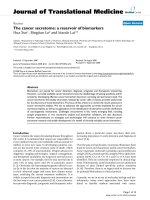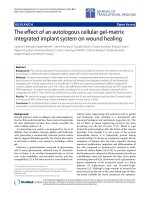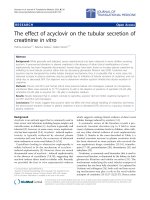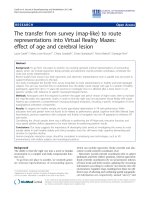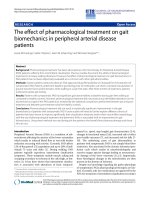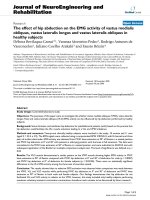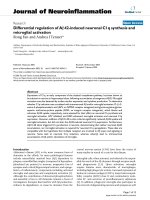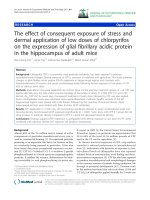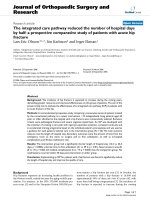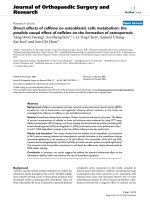báo cáo hóa học: " The effect of hip abduction on the EMG activity of vastus medialis obliquus, vastus lateralis longus and vastus lateralis obliquus in healthy subjects" pot
Bạn đang xem bản rút gọn của tài liệu. Xem và tải ngay bản đầy đủ của tài liệu tại đây (1.05 MB, 8 trang )
BioMed Central
Page 1 of 8
(page number not for citation purposes)
Journal of NeuroEngineering and
Rehabilitation
Open Access
Research
The effect of hip abduction on the EMG activity of vastus medialis
obliquus, vastus lateralis longus and vastus lateralis obliquus in
healthy subjects
Débora Bevilaqua-Grossi*
1
, Vanessa Monteiro-Pedro
2
, Rodrigo Antunes de
Vasconcelos
1
, Juliano Coelho Arakaki
3
and Fausto Bérzin
4
Address:
1
Department of Biomechanics, Medicine and Rehabilitation of Locomotor Apparatus, Ribeirão Preto School of Medicine, University of
São Paulo (FMRP-USP), Ribeirão Preto, SP, Brazil,
2
Department of Physical Therapy, Federal University of São Carlos (UFSCar), SP, Brazil,
3
Department of Physical Therapy, University for Development of Pantanal State and Region (UNIDERP), Campo Grande, MS, Brazil and
4
Department of Morphology, Piracicaba School of Dentistry, State University of Campinas (FOP-UNICAMP), Piracicaba, SP, Brazil
Email: Débora Bevilaqua-Grossi* - ; Vanessa Monteiro-Pedro - ; Rodrigo Antunes de
Vasconcelos - ; Juliano Coelho Arakaki - ; Fausto Bérzin -
* Corresponding author
Abstract
Study design: Controlled laboratory study.
Objectives: The purposes of this paper were to investigate (d) whether vastus medialis obliquus (VMO), vastus lateralis
longus (VLL) and vastus lateralis obliquus (VLO) EMG activity can be influenced by hip abduction performed by healthy
subjects.
Background: Some clinicians contraindicate hip abduction for patellofemoral patients (with) based on the premise that
hip abduction could facilitate the VLL muscle activation leading to a VLL and VMO imbalance
Methods and measures: Twenty-one clinically healthy subjects were involved in the study, 10 women and 11 men
(aged X = 23.3 ± 2.9). The EMG signals were collected using a computerized EMG VIKING II, with 8 channels and three
pairs of surface electrodes. EMG activity was obtained from MVIC knee extension at 90° of flexion in a seated position
and MVIC hip abduction at 0° and 30° with patients in side-lying position with the knee in full extension. The data were
normalized in the MVIC knee extension at 50° of flexion in a seated position, and were submitted to ANOVA test with
subsequent application of the Bonferroni multiple comparisons analysis test. The level of significance was defined as p ≤
0.05.
Results: The VLO muscle demonstrated a similar pattern to the VMO muscle showing higher EMG activity in MVIC
knee extension at 90° of flexion compared with MVIC hip abduction at 0° and 30° of abduction for male (p < 0.0007)
and MVIC hip abduction at 0° of abduction for female subjects (p < 0.02196). There were no statistically significant
differences in the VLL EMG activity among the three sets of exercises tested.
Conclusion: The results showed that no selective EMG activation was observed when comparison was made between
the VMO, VLL and VLO muscles while performing MVIC hip abduction at 0° and 30° of abduction and MVIC knee
extension at 90° of flexion in both male and female subjects. Our findings demonstrate that hip abduction do not
facilitated VLL and VLO activity in relation to the VMO, however, this study included only healthy subjects performing
maximum voluntary isometric contraction contractions, therefore much remains to be discovered by future research
Published: 03 July 2006
Journal of NeuroEngineering and Rehabilitation 2006, 3:13 doi:10.1186/1743-0003-3-13
Received: 18 November 2005
Accepted: 03 July 2006
This article is available from: />© 2006 Bevilaqua-Grossi et al; licensee BioMed Central Ltd.
This is an Open Access article distributed under the terms of the Creative Commons Attribution License ( />),
which permits unrestricted use, distribution, and reproduction in any medium, provided the original work is properly cited.
Journal of NeuroEngineering and Rehabilitation 2006, 3:13 />Page 2 of 8
(page number not for citation purposes)
Introduction
Patellofemoral pain syndrome (PFPS) presents one of the
most perplexing pathologic conditions in orthopedic and
sports medicine clinics, as well as in rehabilitation depart-
ments, and it was referred to by Dye [1] as the "black hole
of orthopedics" because of the lack of clarity regarding the
etiological factors that contribute to dysfunction or to spe-
cific treatment protocols and the causative mechanisms
remain imprecisely defined [2].
Dysfunction of the quadriceps muscle has been hypothe-
sized as a cause of patellofemoral pain syndrome (PFPS)
with great emphasis placed on the role of VMO and VL
muscular imbalance [3,4]. Quadriceps dysfunction in
PFPS patients has been assessed in various ways including
decreased magnitude of the electromyographic (EMG)
activity of the quadriceps [5,6], diminished EMG activity
of the VMO in relation to that of the VL [7-9], and the
delayed onset of VMO activation in relation to the VL [10-
12] caused by the inhibition of pain, effusion and atro-
phies[13]. Improved control of patella tracking is neces-
sary for symptomatic relief [14] and the recovery of
quadriceps function is essential to the resolution of the
problem [15]. Consequently, there have been numerous
studies that have sought to identify exercises to selectively
recruit the VMO in an effort to retrain this muscle [7,16-
18]. However, Mirzabeigi et al. [19] suggested that the
VMO muscle cannot be significantly isolated during nine
sets of different exercises.
Since fibers of the VMO attach to the adductor magnus
muscle, it has been hypothesized that activation of the
VMO may be enhanced by combining active knee exten-
sion with volitional hip adduction [4,16,20]. Research in
clinical studies on the treatment of PFPS has reported that
VL activity may also be enhanced by combining knee
extension exercises with hip abduction [21,22]. Fulkerson
[23] noted retinacular tenderness in patients with patel-
lofemoral pain, including some who demonstrated histo-
logical changes within the perineural tissues of the lateral
retinaculum on examination of surgical biopsy speci-
mens. Bevilaqua-Grossi et al. [24] in their anatomical
study dissected the thighs of 32 human cadavers and
showed that the distal fibers of the Vastus Lateralis Obliq-
uus (VLO) were interdigitated with the lateral retinaculum
and the iliotibial tract in all specimens, were subsequently
joined in a common tendon with the VLL on the supero-
lateral border of the patella (Figure 1) and that tightness
of lateral retinaculum could potentially alter the tracking
of the patella in the trochlear groove. Based on this ana-
tomic correlation, Hip abduction exercises are often con-
traindicated by physical therapists because some group of
patient with patellofemoral problems may have tight lat-
eral structures and hip abduction exercises would enhance
VMO and VL muscular imbalance [21].
Considering that previous few studies have investigated
the EMG relationship VMO and VLO with other structures
of the lateral compartment (lateral retinaculum and ili-
otibial tract) and hip abduction strengthening exercises,
the aim of this paper was to analyze the EMG activity of
the VMO, VLL and VLO muscles and verify whether any
difference in activity between these portions occurred dur-
ing MVIC: 1) knee extension at 90° of flexion, 2) hip
abduction at 0° of abduction and 3) hip abduction at 30°
of abduction. The data reported in this paper should be
useful in future functional studies aimed at a clearer
understanding of rehabilitation protocols in PFPS
patients.
Lateral view of the right thigh showing the origin of the obliq-uus portion of the vastus lateralis muscle (vastus lateralis obliquus – VLO) in the lateral intermuscular septum (LIS) and its insertion in the superior -lateral border of the patella (P)Figure 1
Lateral view of the right thigh showing the origin of the obliq-
uus portion of the vastus lateralis muscle (vastus lateralis
obliquus – VLO) in the lateral intermuscular septum (LIS)
and its insertion in the superior -lateral border of the patella
(P). VLL – vastus lateralis longus. Bevilaqua-Grossi et al.
(2004)
46
.
Journal of NeuroEngineering and Rehabilitation 2006, 3:13 />Page 3 of 8
(page number not for citation purposes)
Methods
Subjects
Twenty-one healthy volunteers (11 males and 10
females), aged from 19 to 28 (X = 23.3 ± 2.9), participated
in this study. They were recruited from Piracicaba Meth-
odist University and all reported no history of orthopedic
disorders, surgical procedures, knee pain or other major
musculoskeletal injuries. Prior to participation, all sub-
jects read, accepted and signed a consent form that was
approved by the Human Research Ethics Committee at
the State University of Campinas.
Instrumentation
Silver/silver chloride surface electrodes placed in a bipolar
configuration, with a 10 mm contact area and an inter-
electrode distance of 2 cm, were used to assess the level of
electromyographic activity of the VMO, VLL and VLO
muscles. Before the electrode placement the sites were pre-
pared by shaving, abrading and cleaning with isopropyl
alcohol to reduce the surface impedance to less than 5 and
10 kΩ for men and women, respectively. A quadriceps line
was drawn from the anterior superior iliac spine to the
center of the patella for the quadriceps portion placement
[24]. A surface electrode for the VMO was placed with a
medial inclination of 55° from the quadriceps line
[25,26]. The VLL electrode was placed 15 cm from the
superior edge of patella at a lateral inclination of 13.6°
and the VLO shows its superficial part around 2.2 cm of
the lateralis epicondyle with a superficial length of around
8.9 cm with a 50.4° of lateral inclination[27]. A ground
electrode was placed over the tibial tubercle of the tested
lower limb. The same investigator performed all electrode
placements.
A calibrated Viking II with eight channels (Nicolet Bio-
medical Instruments) and a computer were used to collect
all EMG data (CMRR of 110 dB, sampling 1000 Hz, gain
200, band pass filter of 10 to 1000 Hz). All signals were
viewed on a display screen prior to collection to ensure
that there were no visible artifacts.
Procedures
Following EMG preparation, the subjects were instructed
to perform 3 repetitions of the following three sets of exer-
cises: 1) MVIC knee extension at 90° of flexion in a seated
position; 2) MVIC hip abduction at 0° of abduction, with
patients in side-lying position with the knee in full exten-
sion; 3) MVIC hip abduction at 30° of abduction, with
patients in side-lying position with the knee in full exten-
sion
During the MVIC knee extension test, the subjects were
positioned seated in a leg extension machine (Queens,
São Paulo, BRA) with the knee and hip at 90° of flexion
and the ankle in a neutral position (figure 2). For the
MVIC hip abduction (0° and 30°) tests, the subjects were
positioned on their sides lying on a divan with the test
lower limb placed above and with both lower limbs posi-
tioned at neutral hip and knee flexions, as measured by
the investigator. For the maintenance of these positions
the thighs were stabilized with padding and the calves
were fixed with a belt applied immediately distal to the
knees (Figure 3 and 4).
Before data collection procedures began, each subject
received a verbal explanation and a demonstration of the
testing activities and practice trials were performed to
ensure the subject's comprehension and safety. After
familiarization, the subjects randomly performed three
MVIC for 5 seconds with a 2 minute rest between repeti-
tions and 10 minutes between each set of exercises to pre-
vent muscle exhaustion. EMG signals were collected
throughout each MVIC and verbal encouragement was
provided throughout the testing.
Data analysis
The normalization of the VMO, VLL and VLO EMG signals
for the three exercises (knee extension at 90° of flexion,
MVIC hip abduction at 0° of abduction, MVIC hip abduc-
tion at 30° of abduction) were obtained dividing the
highest EMG value of the MVIC trials by the EMG value of
a MVIC knee extension at 50° of flexion in a seated posi-
tion and multiplied by 100 [16]. The normalization pro-
cedure performed at 50° of knee flexion in a seated
position followed the same protocol of positioning for
the test at 90° of knee flexion in a seated position. Nor-
malized EMG readings were analyzed by two-way analysis
of variance with repeated measurements. Post hoc compar-
isons within the values obtained for each of the muscles
Maximum voluntary isometric contraction at 90 degrees of knee extensionFigure 2
Maximum voluntary isometric contraction at 90 degrees of
knee extension.
Journal of NeuroEngineering and Rehabilitation 2006, 3:13 />Page 4 of 8
(page number not for citation purposes)
were realized by the Bonferroni multiple comparisons
analysis. Significance was defined as p ≤ 0.05.
Results
Maximum voluntary isometric contractions for knee
extension at 90° of flexion resulted in a significantly
higher EMG activity for the VMO muscle compared with
hip abduction at 0° and 30° of abduction for both male
(p < 0.008) and female (p < 0.0005) subjects (Table 1, Fig-
ure 5).
There were no statistically significant differences in the
VLL EMG activity among the three types of exercise tested
(Table 1, Figure 5). The VLO muscle demonstrated a sim-
ilar pattern to the VMO muscle showing higher EMG
activity in MVIC knee extension at 90° of flexion com-
pared with MVIC hip abduction at 0° and 30° of abduc-
tion for male (p < 0.0007) and with MVIC hip abduction
at 0° of abduction for female subjects (p < 0.02196)
(Table 1, Figure 5). There were no significant differences
between gender with respect to the EMG activity of the
VMO, VLL and VLO muscles among the three types of
exercise tested.
No selective EMG activation was observed when compar-
ison was made between the VMO, VLL and VLO muscles
while performing MVIC knee extension at 90° of flexion
and MVIC hip abduction at 0° and 30° of abduction for
both male and female subjects.
Discussion
The primary purpose of this article was to investigate
whether VMO, VLL and VLO EMG activity can be influ-
enced by hip abduction. The results showed that no selec-
tive EMG activation was observed when comparison was
made between the VMO, VLL and VLO muscles while per-
forming MVIC knee extension at 90° of flexion or MVIC
hip abduction at 0° and 30° of abduction for both male
and female subjects. These results are in agreement with
Hertel et al. [4] who investigated the EMG activity of the
VMO, VLL and gluteus medius in eight healthy young
adult volunteers with no history of knee injury while per-
forming uniplanar knee extension, knee extension/hip
adduction, knee extension/hip abduction and found no
significant differences in the VMO/VL ratio between the
exercises. It is well established in the literature that the iso-
lation of any of the quadriceps components or selective
strengthening is unlikely, especially concerning the VMO/
VLL muscles [28,29]. Our findings demonstrate that hip
abduction do not facilitated VLL and VLO activity in rela-
tion to the VMO in healthy subjects performing maxi-
mum voluntary isometric contraction.
We are unaware of any studies which have demonstrated
the characteristics of EMG activity between VMO, VLL and
VLO in subjects performing hip abduction in different
positions.
The secondary purpose of the present work was investigat-
ing the EMG activity of the VMO, VLL and VLO while per-
forming the three exercises tested. The results showed that
the VLO presents a significantly different behavior com-
pared with the VLL, whereas the VLO showed a similar
Maximum voluntary isometric contraction at 30 degrees of hip abduction in side-lying positionFigure 4
Maximum voluntary isometric contraction at 30 degrees of
hip abduction in side-lying position. The subjects were
instructed to maintain an isometric quadriceps contraction at
full knee extension while performing the task.
Maximum voluntary isometric contraction of hip abduction in neutral in side-lying positionFigure 3
Maximum voluntary isometric contraction of hip abduction in
neutral in side-lying position. The subjects were instructed to
maintain an isometric quadriceps contraction at full knee
extension while performing the task.
Journal of NeuroEngineering and Rehabilitation 2006, 3:13 />Page 5 of 8
(page number not for citation purposes)
motor unit recruitment to the VMO, producing higher
EMG activity in MVIC knee extension at 90° of flexion
compared with MVIC hip abduction at 0° and 30° of
abduction. No significant differences were found in the
EMG activity of the VLL among the three exercises tested,
thus verifying that the VLL and VLO demonstrate not only
anatomical but distinct motor unit recruitment character-
istics. Bevilaqua-Grossi et al. [27] investigated the EMG
activity of the VMO, VLL and VLO muscles in 21 healthy
subjects performing open kinetic chain knee extension at
15° and 90° of flexion. The results showed that the VLO
and VMO were more active at 90° of flexion compared
with the higher activity of the VLL at 15° of flexion, dem-
onstrating that the VMO and VLO muscle have the same
behavior suggesting a synchronic antagonist stability role
of the patella in healthy people. The striking difference
between VLL and VLO behavior concerning the EMG
activity observed, could be because the VLL fiber align-
ment tends to traction the patella, offering greater contri-
bution to knee extension than patella stabilization,
different from the VLO which spirally and inclination fib-
ers in relation to femoral dyaphisis promotes patella
alignment associated with the VMO [24]
Hertel et al. [4] reported that both the VMO and VL are
more activated in uniplanar knee extension when com-
pared with knee extension/hip adduction or abduction.
These results are not entirely supported by our results, in
which the VLL showed no significant differences between
MVIC knee extension at 90° of flexion compared with
MVIC hip abduction at 0° and 30°. These conflicting
results concerning the VLL recruitment pattern may be
because these authors tested the exercises in closed kinetic
chain while the three exercises tested in the current work
were performed in open kinetic chain.
Possible limitations of this study may be related to the
non collection of gluteus medius EMG activity during the
three exercises tested. Normalization methods using other
types of muscle contractions or other angles of the knee
joint may result in different VMO/VLL/VLO ratios
between studies that use different methods of normaliza-
tion. The absence of increased EMG activity with hip
abduction could have been due limitations in EMG
recordings from MVCs. Results might be different when
studying submax voluntary contractions. Although nor-
malized EMG data are useful in measuring relative levels
of activity between muscles, such information is not
indicative of muscular strength or muscular balance [58].
Future studies of this research group will focus on subjects
with patellofemoral pain and investigate the recruitment
patterns provided from such subjects performing the same
task.
Clinical implications
Bevilaqua-Grossi et al. [24] dissected the thighs of 32
human cadavers and determined the anatomical organi-
zations of the VLL and VLO muscles. The distal fibers of
the VLO were interdigitated with the lateral retinaculum
and the iliotibial tract in all specimens, which subse-
quently joined in a common tendon with the VLL on the
superolateral border of the patella. These results agree
with previous anatomical studies which describe the ori-
gin [30-34] and insertion of these muscles [35,36]. Thus,
tightness of the lateral retinaculum, perhaps as a result of
increased tension in the iliotibial tract, could potentially
alter the tracking of the patella in the trochlear groove,
becoming an important factor in the etiology of patel-
lofemoral pain [37]. Following this theory, some clini-
cians contraindicate rehabilitation exercises using hip
abduction in patients with patellofemoral complaints
based on the premise of avoiding excessive tightness of
the lateral structures or a VLL and VMO imbalance, since
the anatomical origin of the iliotibial tract has a close rela-
tion with the iliotibial band and the gluteus medius mus-
cles [21,38]. This theory is not supported by recent works
which investigated the role of pelvic control as a contrib-
Table 1: Summarized results of normalized EMG values of VMO,
VLL and VLO muscles during MVIC knee extension at 90° of
flexion and MVIC hip abduction at 0° and 30° of abduction (N =
21) The results are shown as a percentage of MVIC at 50° of knee
flexion in a seated position
Test procedure VMO (%)VLL (%)VLO (%)
Hip abduction at 30°
Male 53.70 88.31 75.70
Female 96.07 119.61 103.98
Hip abduction at 0°
Male 69.05 110.62 90.25
female 87.09 100.13 92.30
MIVC at 90° of knee flexion
Male 144.91
c
115.31 146.72
d
female 165.97
b
141.30 162.61
a
p ≤ 0,05
Letters demonstrate higher EMG activity of the same muscle in which
there were statistically significantly differences between the three
exercises
a
p = 0,02196 High EMG activity MVIC knee extension at 90° of
flexion vs MVIC hip abduction at 0° of abduction
b
p = 0,008 High EMG activity MVIC knee extension at 90° of flexion
vs MVIC hip abduction at 0° and 30° of abduction
c
p = 0,000055 High EMG activity MVIC knee extension at 90° of
flexion vs MVIC hip abduction at 0° and 30° of abduction
d
p = 0,000761 High EMG activity MVIC knee extension at 90° of
flexion vs MVIC hip abduction at 0° and 30° of abduction
Journal of NeuroEngineering and Rehabilitation 2006, 3:13 />Page 6 of 8
(page number not for citation purposes)
Normalized EMG activity expressed as RMS values from healthy subjects performing MVIC knee extension at 90° of flexion, MVIC hip abduction at 0° and 30° of abductionFigure 5
Normalized EMG activity expressed as RMS values from healthy subjects performing MVIC knee extension at 90° of flexion,
MVIC hip abduction at 0° and 30° of abduction. A) Significantly higher VMO activity for both male and female subjects per-
forming MVIC knee extension at 90° of flexion when compared to MVIC hip abduction at 0° and 30° of abduction. B) VLL
EMG activity without significant differences among the three exercises tested. C) Significantly higher VLO activity for male sub-
jects was observed in MVIC knee extension at 90° of flexion compared with MVIC hip abduction at 0° and 30° of abduction
and for female subjects performing MVIC knee extension at 90° of flexion when compared with MVIC hip abduction at 0° and
30° of abduction.
Journal of NeuroEngineering and Rehabilitation 2006, 3:13 />Page 7 of 8
(page number not for citation purposes)
uting factor in the development of anterior knee pain [39-
42].
Ireland et al. [39], using hand held dynamometers, inves-
tigated hip abduction and external rotation isometric
strength in 15 female patients with patellofemoral pain
compared with a control group. They found significant
weakness of the hip abductors and external rotators of the
patellofemoral pain group. It is postulated that in the
absence of pelvic control due to hip abductor and external
rotator weakness, the femur may adduct and internally
rotate, further increasing lateral patellar contact pressure
[43]. These findings suggest that hip abduction exercises
may be indicated and necessary for patients with patel-
lofemoral pain who present absence of satisfactory pelvic
control.
Conclusion
The results showed that no selective EMG activation was
observed when comparison was made between the VMO,
VLL and VLO muscles while performing MVIC at 30° and
0° of hip abduction and 90° of knee flexion for both male
and female subjects. Our findings demonstrate that hip
abduction do not facilitated VLL and VLO activity in rela-
tion to the VMO, however, this study included only
healthy subjects performing maximum voluntary isomet-
ric contraction contractions, therefore much remains to be
discovered by future research
References
1. Dye SF: The pathophysiology of patellofemoral pain. Presented
at 48th Annual National Athletic Trainers Association Meeting; June 19,
1997; Salt Lake City, US .
2. Wilk KE, Reinold MM: Principles of patellofemoral rehabilita-
tion. Sports Medicine and Arthroscopy Review 2001, 9:325-36.
3. Stokes M, Young A: Investigation of quadriceps inhibition:
implications for clinical practice. Physiotherapy 1984, 70:425-28.
4. Hertel J, Earl JE, Tsang KKW, Miller SJ: Combining isometric knee
extension exercises with hip adduction or abduction does
not increase quadriceps EMG activity. Br J Sports Med 2004,
38:210-13.
5. Moller BN, Krebs B, Tidemand-Dal C, et al.: Isometric contrac-
tions in the patellofemoral pain syndrome. An electromyo-
graphic study. Arch Orthop Trauma Surg 1986, 105:24-7.
6. Thomee R, Renstrom P, Karlsson J, et al.: Patellofemoral pain syn-
drome in young women. II. Muscle function in patients and
healthy controls. Scand J Med Sci Sports 1995, 5:245-51.
7. Souza DR, Gross MT: Comparison of vastus medialis obliquus:
vastus lateralis muscle integrated electromyographic ratios
between healthy subjects and patients with patellofemoral
pain. Phys Ther 1991, 71:310-6.
8. Callaghan MJ, McCarthy CJ, Oldham JA: Electromyographic
fatigue characteristics of the quadriceps in patellofemoral
pain syndrome. Man Ther 2001, 6:27-33.
9. Tang SF, Chen CK, Hsu R, et al.: Vastus medialis obliquus and
vastus lateralis activity in open and closed kinetic chain exer-
cises in patients with patellofemoral pain syndrome: an elec-
tromyographic study. Arch Phys Med Rehabil 2001, 82:1441-5.
10. Powers CM, Landel R, Perry J: Timing and intensity of vastus
muscle activity during functional activities in subjects with
and without patellofemoral pain. Phys Ther
1996, 76:946-55.
11. Witvrouw E, Sneyers C, Lysens R, et al.: Reflex response times of
vastus medialis oblique and vastus lateralis in normal sub-
jects and in subjects with patellofemoral pain syndrome. J
Orthop Sports Phys Ther 1996, 24:160-5.
12. Cowan SM, Bennell KL, Hodges PW, et al.: Delayed onset of elec-
tromyographic activity of vastus medialis obliquus relative
to vastus lateralis in subjects with patellofemoral pain syn-
drome. Arch Phys Med Rehabil 2001, 82:183-9.
13. Gerber C, Hoppeler H, Claassen H, et al.: The lower-extremity
musculature in chronic symptomatic instability of the ante-
rior cruciate ligament. J Bone Joint Surg [Am] 1985, 67:1034-43.
14. McConnell J: Management of patellofemoral problems. Man
Ther 1996, 1:60-6.
15. Natri A, Kannus P, Jarvinen M: Which factors predict the long
term outcome in chronic patellofemoral pain syndrome? A
seven year prospective follow up. Med Sci Sports Exerc 1998,
30:1572-77.
16. Hanten WP, Schulthies SS: Exercise effect on electromyo-
graphic activity of the vastus medialis oblique and vastus lat-
eralis muscles. Phys Ther 1990, 70:561-5.
17. Grabiner MD, Koh RJ, Von Haefen L: Effect of concomitant hip
joint adduction and knee joint extension forces on quadri-
ceps activation. Eur J Musculoskel Res 1992, 1:155-60.
18. Monteiro-Pedro V, Vitti M, Bérzin F, et al.: The effect of free isot-
onic and maximal isometric contraction exercises of the hip
adduction on vastus medialis oblique muscle: an electromy-
ographic study. Electromyogr Clin Neurophysiol 1999, 39:435-40.
19. Mirzabeigi E, Jordan C, Gronley JK, Rockowitz NL, Perry J: Isolation
of the vastus medialis oblique muscle during exercise. Am J
Sports Med 1999, 27:50-3.
20. Cerny K: Vastus medialis oblique/vastus lateralis muscle
activity ratios for selected exercises in persons with and
without patellofemoral pain syndrome. Phys Ther 1995,
75:672-83.
21. Zappala FG, Taffel CB, Scuderi GR: Rehabilitation of patellofem-
oral joint disorders. Orthop Clin North Am 1992, 23:555-66.
22. Host J, Craig R, Lehman R: Patellofemoral dysfunction in tennis
players: a dynamic problem. Clin Sports Med 1995, 14:177-203.
23. Fulkerson JP: Evaluation of the peripatellar soft tissues and
retinaculum in patients with patellofemoral pain. Clin Sports
Med 1989, 8:197-202.
24. Bevilaqua-Grossi D, Monteiro-Pedro V, Sousa GC, Silva Z, Bérzin F:
Contribution to the anatomical study of the oblique portion
of the vastus lateralis muscle. Braz J Morphol Sci 2004, 21:47-52.
25. Lieb FJ, Perry J: Quadriceps function: an anatomical and
mechanical study using amputated limbs. J Bone Joint Surg [Am]
1968, 50:1535-48.
26. Wilk KE, Davies GJ, Mangine RE, Malone TR: Patellofemoral disor-
ders: a classification system and clinical guidelines for nonop-
erative rehabilitation. J Orthop Sports Phys Ther 1998, 28:307-22.
27. Bevilaqua-Grossi D, Monteiro-Pedro V, Bérzin F: Análise funcional
dos estabilizadores da patela. Acta Ortop Bras 2004, 12:99-104.
28. Powers CM: Rehabilitation of patellofemoral joint disorders: a
critical review. J Orthop Sports Phys Ther 1998, 28:345-54.
29. Fredericson M, Powers CM: Practical management of patel-
lofemoral pain. Clin J Sport Med 2002, 12:36-8.
30. Chiarugi G: Insituzione di anatomia dell'uomo 7th edition. Societa Edi-
trice Libraria Milano: Torino; 1958.
31. Hallisey MJ, Doherty N, Bennet WF, Fulkerson JP:
Anatomy of the
junction of the vastus lateralis tendon and patella. J Bone Joint
Surg [Am] 1987, 69:545-49.
32. Hamilton WJ: Tratado de anatomia humana 2nd edition. Interameri-
cana: Rio de Janeiro; 1982.
33. Scharf W, Weinstabl R, Firbas W: Anatomische untrsuchungen
am streckapparat des kniegelenks und ihre klinische rele-
vanz. Unfallchirurg 1986, 89:456-62.
34. Weinstabl R, Scharf W, Firbas W: The extensor apparatus of the
knee joint and its peripheral vasti: anatomic investigation
and clinical relevance. Surg Radiol Anat 1989, 11:17-22.
35. Testut L, Latarget A: Tratado de anatomia topográfica com aplicações
médico-cirúrgicas 5th edition. Salvat: Barcelona; 1932.
36. Testut L, Latarget A: Tratado de anatomia humana 9th edition. Salvat:
Barcelona; 1988.
37. Bizzini M, Childs JD, Piva SR, Delitto A: Systematic review of the
quality of randomized controlled trials for patellofemoral
pain syndrome. J Orthop Sports Phys Ther 2003, 33:4-20.
38. Winslow J, Yoder E: Patellofemoral pain in female ballet danc-
ers: correlation with iliotibial band tightness and tibial exter-
nal rotation. J Orthop Sports Phys Ther 1995, 22:18-21.
Publish with Bio Med Central and every
scientist can read your work free of charge
"BioMed Central will be the most significant development for
disseminating the results of biomedical research in our lifetime."
Sir Paul Nurse, Cancer Research UK
Your research papers will be:
available free of charge to the entire biomedical community
peer reviewed and published immediately upon acceptance
cited in PubMed and archived on PubMed Central
yours — you keep the copyright
Submit your manuscript here:
/>BioMedcentral
Journal of NeuroEngineering and Rehabilitation 2006, 3:13 />Page 8 of 8
(page number not for citation purposes)
39. Ireland ML, Wilson JD, Ballantyne BT, Davis IM: Hip strength in
females with and without patellofemoral pain. J Orthop Sports
Phys Ther 2003, 33:671-76.
40. Mascal CL, Landel R, Powers CM: Management of patellofemoral
pain targeting hip, pelvis, and trunk muscle function: 2 case
reports. J Orthop Sports Phys Ther 2003, 33:647-60.
41. Powers CM, Ward SR, Fredericson M, Guillet M, Shellock FG: Patel-
lofemoral kinematics during weight-bearing and non-weight-
bearing knee extension in persons with lateral subluxation of
the patella: a preliminary study. J Orthop Sports Phys Ther 2003,
33:677-85.
42. Lee TQ, Morris G, Csintalan RP: The influence of tibial and fem-
oral rotation on patellofemoral contact area and pressure. J
Orthop Sports Phys Ther 2003, 33:686-93.
43. Huberti HH, Hayes WC: Patellofemoral contact pressures. The
influence of Q-angle and tendofemoral contact. J Bone Joint
Surg Am 1984, 66:715-24.
